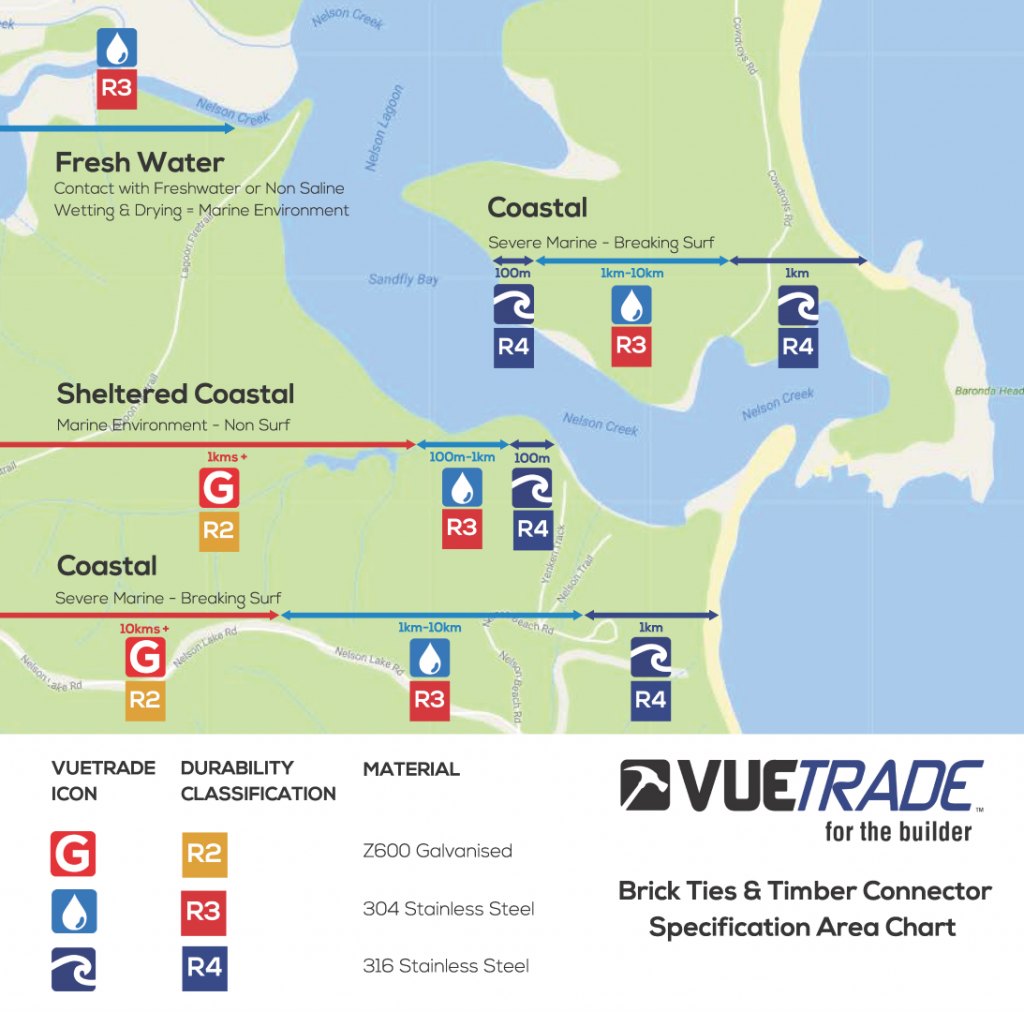Timber Connector Specification Icons and Area Usage Chart
To assist with proper product specification and to ensure the correct grade steel is used for the local area or environment; VUETRADE have developed unique and easy to understand icons for our Timber Connectors range.
We also have a coordinating chart which gives a visual guide as to which products should be used in proximity to different environmental factors. Further details and discussions on different building environments is also included.
Either view the details and guidelines here, or download the PDF version.
PDF VUETRADE Timber Connectors Specification Icons & Area Chart
Timber Connector Specification Icons
 Standard/Galvanised
Standard/Galvanised
• Internal/enclosed
• Exterior/exposed inland areas except if in contact with fresh water or non-saline wetting & drying
• R2 Classified – to be used no closer than 10km to surf coast, or 1km to sheltered coast. Refer AS/NZS 2699.1 (2000)
 Marine Environment – 304SS
Marine Environment – 304SS
• Marine Environment – 100m up to 1km from a non-surf coast and from 1km up to 10km from a surf coast
• External applications in contact with freshwater or subject to non-saline wetting and drying (classed as Marine Environment as per AS 3700 – 2011: Section 5: Design for Durability)
• Minimum steel grade required Stainless Steel 304
• R3 Classified – to be used 1km – 10km from surf coast, or 100mt – 1km from sheltered coast. Refer AS/NZS 2699.1 (2000)
 Severe Marine – 316SS
Severe Marine – 316SS
• Severe Marine – 100m from a non-surf coast and up to 1km from a surf coast
• Minimum Steel Grade Stainless Steel 316
• R4 Classified – to be used within 3km of coastal or industrial areas. Refer AS/NZS 2699.1 (2000)
• No ‘Tea Staining’ a superficial ‘rust’ look that occurs on lower grades of Stainless Steel including 304.
Timber Connector Specification Area Chart
This chart provides a visual illustration of different building environments relative to the above Icons.

EXAMPLE: Say your application is near the coast: work out the type of coastal environment, the distance from the building, consult the chart and guidelines above and identify the steel grade required!
- What type of environment?
- Breaking Surf?
- Sheltered Coastal?
- Fresh Water?
- Distance?
- Breaking Surf:
- 0-1kms?
- 1-10kms?
- 10kms+?
- Sheltered Coastal:
- 0-100 metres?
- 100m-1km?
- 1km+?
- Fresh Water – if subject to frequent wetting and drying.
- Breaking Surf:
Timber Connector Specification Environments
Breaking Surf:
Breaking surf environments, as the name indicates, relates to areas in proximity to the coast where there is rolling surf breaking onto beaches or rocks. In these environments, salt content in the air is obviously much higher and is carried by the wind. The closer you are to breaking surf the more the elements will affect your home or construction. It’s also important to note that windblown salt spray can reach a long way inland, depending on the conditions. These types of areas are classified as Severe Marine as the degrading of steel from saltwater attack happens very quickly.
Sheltered Coastal:
Sheltered Coastal environments are locations where there is no breaking surf in the vicinity, for example very sheltered bay areas, salt water harbours and salt water river estuaries. The salt content in the air will be lower as the water isn’t breaking, however these areas are considered Marine Environment as degrading of steel will occur due to the salt content in the air.
Freshwater:
Where there will be constant contact with freshwater or frequent wetting and drying. This could also apply to areas where there is excessive dampness and any timber connectors used will be constantly damp.
Pools:
Areas of decking around pools, whether it is a freshwater or saltwater pool, will be subjected to more frequent wetting and drying. If it is a Saltwater pool it is recommended to use Stainless Steel Brackets as degradation and corrosion will occur if galvanised brackets are used. As with Freshwater above, if there will be excessive splashing and frequent wetting and drying of the brackets from non-saltwater pool, it may be more practical to use stainless steel fixings and brackets.
Standard:
Standard locations are inland areas that are not exposed to salt attack or freshwater wetting and drying.
